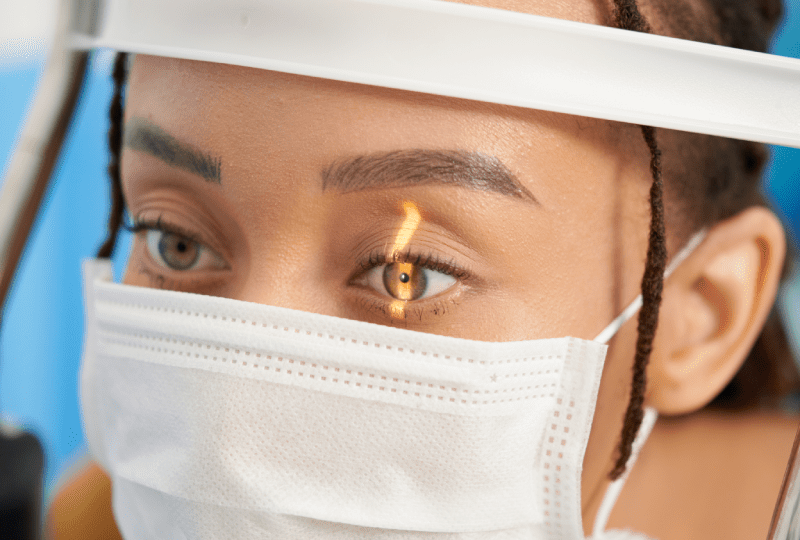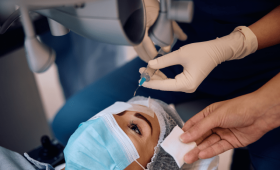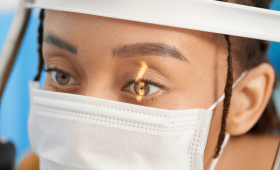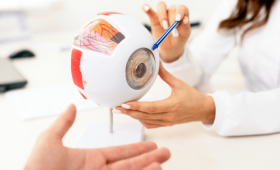Eye pressure, medically known as Glaucoma, is a serious eye disease usually caused by elevated intraocular pressure, which damages the optic nerve and can lead to permanent vision loss if left untreated. The root cause of the disease is an imbalance in the production of fluid within the eye (aqueous humor) or obstruction of the drainage channels.
Glaucoma progresses insidiously and often shows no symptoms in the early stages, making regular eye exams vital. The goal of treatment is to reduce intraocular pressure (IOP) to alleviate the pressure on the optic nerve. This is achievable with medications (eye drops), laser treatments, and surgical operations.
What Is Eye Pressure (Glaucoma) And How Does It Occur?
Eye pressure occurs when the intraocular pressure rises above normal levels due to blockage in the drainage channels of the eye’s internal fluid (aqueous humor) or increased fluid production. This high pressure gradually causes permanent damage to the delicate optic nerve fibers that carry visual information to the brain. Glaucoma usually progresses slowly and painlessly, so the individual may not notice vision loss until advanced stages. If left untreated, nerve damage progresses, and the visual field gradually narrows, ultimately leading to blindness. Early diagnosis and regular follow-up are critical to prevent this condition.
What Is The Primary Goal Of Glaucoma Treatment And How Does It Work?
The primary and foremost goal of glaucoma treatment is to reduce intraocular pressure (IOP) to a safe target level. This target level is personalized according to the degree of damage in each patient to prevent further damage to the optic nerve. Treatment aims to lower IOP by either reducing fluid production with eye drops or increasing drainage. If eye drops are insufficient, laser treatment (SLT) or surgical operations (Trabeculectomy) are used to restore the balance of the fluid within the eye, aiming to protect the optic nerve.
What Medications Are Used As The First Step In Eye Pressure Treatment?
Eye drops are typically prescribed as the first step in eye pressure treatment. These drops work through two main mechanisms: they either reduce the production of fluid (aqueous humor) inside the eye or facilitate the fluid’s drainage (outflow) from the eye. The most commonly used types of drops include Prostaglandin Analogues (which increase drainage) and Beta Blockers (which reduce fluid production). The effectiveness of the treatment is monitored with regular IOP measurements, and medication choice is made by observing the side effects of the drops.
Do Eye Drops Completely Cure Glaucoma Or Just Keep It Under Control?
Eye drops do not completely cure glaucoma but effectively keep the disease under control. Glaucoma is a chronic disease because the damage to the optic nerve is irreversible. The role of the drops is to lower the intraocular pressure, thereby halting or slowing down the progression of the damage. Treatment needs to be continued lifelong. When used correctly and regularly, the drops can prevent the progression of vision loss in the vast majority of patients.
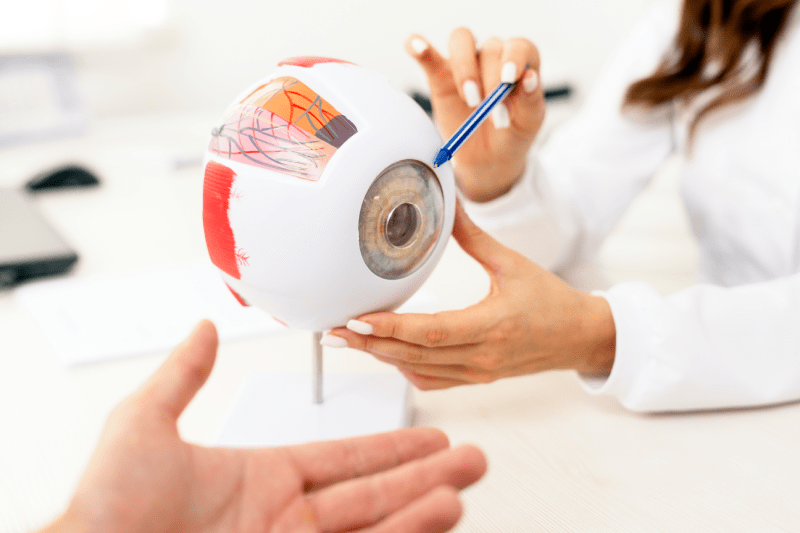
Is Laser Treatment A Permanent Solution For Glaucoma?
Laser treatment (especially Selective Laser Trabeculoplasty – SLT) is an effective, auxiliary solution for a temporary period for glaucoma, but it is not a permanent cure. SLT is a low-energy laser applied to the eye’s drainage network (trabecular meshwork). This application temporarily revitalizes the function of the drainage channels, thus lowering the intraocular pressure. Its effect typically lasts for a few years and can be repeated if necessary. This method is preferred when drop therapy is insufficient or when the patient does not wish to use drops.
In Which Cases Is Surgical Operation Required For Eye Pressure?
Surgical operation for eye pressure is usually required when medications and laser treatment are not sufficiently effective or when the disease continues to progress despite the IOP being under control. Trabeculectomy, the most commonly performed surgical method, creates a new drainage channel for the fluid inside the eye to flow out. Other surgical options include tube implantations or less invasive glaucoma surgeries (MIGS). Surgery is the final and most effective step to stop vision loss.
What Is The Success Rate Of Glaucoma Surgeries And How Long Do They Last?
The success rate of glaucoma surgeries (Trabeculectomy) is generally considered high (70-90%), depending on the patient’s type and stage of glaucoma and the experience of the surgeon performing the operation. Success means keeping the IOP at the targeted safe level. The effect of the surgery is usually long-lasting, but some patients may require drops again or additional surgery years later to maintain IOP control. The surgery itself takes approximately 45-90 minutes.
Does Glaucoma Treatment Restore Vision?
Unfortunately, glaucoma treatment does not restore vision. The damage to the optic nerve caused by glaucoma is permanent. The sole purpose of the treatment is to preserve existing vision and halt the progression of the disease. Therefore, the most critical factor in glaucoma is early diagnosis through regular check-ups before the damage progresses. It is important for patients to have realistic expectations that they will not regain the vision field lost with the treatment.
Does Laser Treatment (SLT) Cause Side Effects?
Laser treatment (SLT), although generally a safe and minimally invasive procedure, can cause some temporary side effects. The most common side effects include mild redness, pain, or temporary blurriness in the eye after the procedure. Rarely, a temporary and short-term increase in intraocular pressure may be seen after SLT. These conditions usually resolve spontaneously within a few hours or days and are controlled with prescribed drops.
Which Treatment Method Has The Fewest Side Effects For Eye Pressure?
The treatment method with the fewest side effects for eye pressure is generally considered to be Selective Laser Trabeculoplasty (SLT) and some Minimally Invasive Glaucoma Surgeries (MIGS). SLT has fewer side effects than traditional lasers because it targets only pigmented cells without causing thermal damage to the tissue. MIGS procedures, on the other hand, involve small incisions and utilize the eye’s natural drainage pathways, offering faster recovery and a lower risk of complications compared to traditional surgeries.
What Are The Risks Associated With Long-Term Use Of Glaucoma Medications?
Long-term use of glaucoma medications can often lead to irritation of the eye surface, dry eye, redness, itching, and allergic reactions. Some medications (such as Beta Blockers) may also cause systemic side effects, such as a decrease in heart rate or triggering respiratory problems (in asthmatic patients) when absorbed systemically. To manage these side effects, doctors may prefer different drug classes or preservative-free formulations.
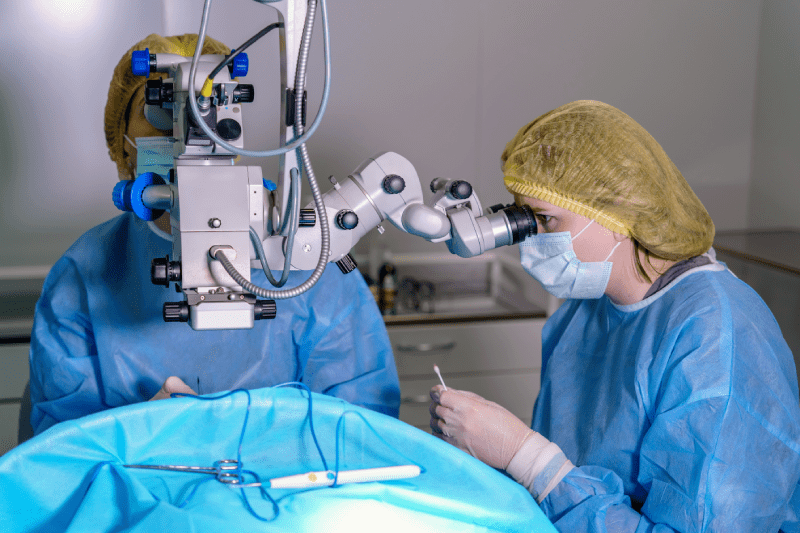
How Long Does Eye Pressure Surgery Take And Is Hospital Stay Required?
Eye pressure surgeries (Trabeculectomy or MIGS) usually last between 30 and 90 minutes and are mostly performed under local anesthesia. After major surgeries like traditional Trabeculectomy, the patient may generally need to stay in the hospital for one night, depending on the doctor’s assessment. In less invasive procedures like MIGS, the patient can usually be discharged on the same day. Close monitoring during the first 24 hours after surgery is vital.
Is Temporary Blurring Of Vision Normal After Surgery?
Yes, experiencing temporary blurring of vision after glaucoma surgery is quite normal. This condition is caused by changes in the internal structure of the eye during surgery, temporary swelling (edema) of the cornea, and the medications used. The blurriness generally subsides slowly within the first few days or weeks. Patients need to be patient to achieve clear vision and avoid movements that could disrupt the healing process.
Who Is Directed To Surgery Faster For Eye Pressure?
The following patient groups are directed to surgery faster for eye pressure: patients with advanced-stage glaucoma who carry a serious risk of visual field loss, patients who do not respond to medication or laser treatment, patients whose glaucoma progression continues even when IOP is under control, and those who experience a sudden pressure increase, especially in some types of narrow-angle glaucoma. Early surgical intervention plays a critical role in preventing permanent damage.
When Does The Effect Of Laser Treatment (SLT) Emerge And How Long Does It Last?
The IOP-lowering effect of laser treatment (SLT) generally begins to emerge within a few days to a few weeks after the procedure. The full effect of the treatment is usually seen within one month. The beneficial effect of SLT on IOP can last between 1 and 5 years on average, though it varies from patient to patient. The treatment can be repeated when the effect diminishes, but its effectiveness may decrease over time.
What Lifestyle Changes Should Patients Diagnosed With Glaucoma Make?
The most important lifestyle changes patients diagnosed with glaucoma must make are strict adherence to regular medication use and doctor check-ups. Furthermore, they should avoid activities that can temporarily increase IOP, such as excessive weight lifting or staying in a head-down position for long periods. Regular, light exercise and a healthy diet support overall eye health, while drinking plenty of water and avoiding smoking are also important.
Can Eye Pressure Rise Again After Surgical Treatment?
Yes, even after surgical treatment (especially Trabeculectomy), eye pressure can rise again. This occurs because the new drainage channel created may narrow or clog again over time due to the development of scar tissue. Medications to slow wound healing are used during and after the surgery to prevent this rise. If the pressure rises again, additional drop therapy, laser, or revision surgeries may be necessary.
How Is Eye Pressure Treatment Managed During Pregnancy?
Eye pressure treatment during pregnancy must be managed very carefully due to potential risks to the fetus. Many glaucoma drops are not recommended during pregnancy. During this period, drops with minimal systemic risk are generally preferred, or drop use is limited. If there is a risk of severe progression, minimal surgical intervention may be considered. The risk-benefit balance must be evaluated separately for each patient.
How Does Eye Pressure Treatment Affect The Visual Field In The Long Term?
Eye pressure treatment preserves vision quality in the long term by halting or slowing down the further narrowing of the visual field. Successful treatment helps stop the loss in the visual field. If treatment is not adhered to and IOP remains high, visual field loss will continue to progress rapidly. Regular visual field tests are the basic tools for monitoring the effectiveness of the treatment in the long term.
What Is Minimally Invasive Glaucoma Surgery (MIGS) And What Are Its Advantages?
Minimally Invasive Glaucoma Surgery (MIGS) is a new generation of glaucoma operations performed with much smaller incisions than traditional surgeries and utilizing the eye’s natural drainage pathways. The key advantages of MIGS are a faster recovery time, lower risk of complications, and the ability to be performed simultaneously with cataract surgery. These methods are generally suitable for mild and moderate-severity glaucoma cases.
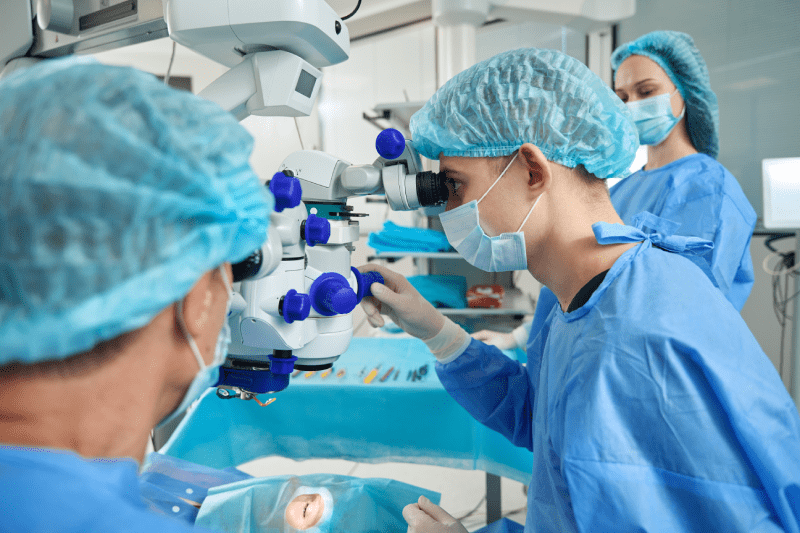
What Is The Importance Of Starting Eye Pressure Treatment Early?
The importance of starting eye pressure treatment early stems from the fact that optic nerve damage is irreversible. The earlier the disease is diagnosed and the earlier treatment is started, the lower the risk of permanent visual field loss. Early treatment usually makes it possible to control IOP with less invasive methods (like a single drop) and can postpone the need for surgery for years.
What Should Be Paid Attention To In The Post-Operative Recovery Process?
The most important things to pay attention to in the post-operative recovery process are regular and correct use of the drops prescribed by the doctor, absolutely avoiding rubbing the eye, protecting the eye from water and shampoo, and refraining from heavy lifting and excessive physical activity. Maximum attention should be paid to hygiene to prevent the risk of infection during the first few weeks.
How Many Times Can Laser Treatment Be Repeated For Eye Pressure?
Selective Laser Trabeculoplasty (SLT) treatment for eye pressure can generally be repeated several times as it does not damage the eye’s drainage tissue. However, the effectiveness of the laser in each repetition may not be as high as the previous one. The decision to repeat is made when the effectiveness of the treatment decreases or when the IOP rises again. Your doctor will determine the most appropriate frequency based on the patient’s eye structure and the response to previous treatment.
How Often Should Treated Glaucoma Patients Have Check-ups?
Treated glaucoma patients should generally attend regular check-ups every 3 to 6 months, depending on the stability of their condition. These checks include intraocular pressure measurement, optic nerve examination, and visual field tests once a year. If there is fluctuation in the treatment’s effectiveness or IOP level, these intervals may be adjusted by the doctor to be more frequent. Regular lifelong follow-up is the key to preserving vision.
Does Nutrition Have A Role In Eye Pressure Treatment?
Nutrition does not have a direct therapeutic role in eye pressure treatment, but it plays an important complementary role in supporting overall eye health and maintaining vascular health. Foods rich in antioxidants (green leafy vegetables, fruits), Omega-3 fatty acids, and controlled caffeine consumption may be beneficial. It is important to avoid excessive fluid consumption or high caffeine intake, as these can cause temporary increases in IOP.
Is Drop Use Continued After Laser And Surgical Treatment?
Most patients continue to use drops after laser treatment because the laser alone may be insufficient to lower the IOP to a sufficient level. After surgical treatment (Trabeculectomy), drop use can usually be completely stopped or significantly reduced, depending on the success of the surgery. However, if the pressure rises again, drop therapy may be resumed. The goal of the surgery is to reduce drop dependence.
What Are The Latest Technological Advancements Used In Glaucoma Treatment?
The latest technological advancements used in glaucoma treatment include Minimally Invasive Glaucoma Surgery (MIGS) devices (small stents and shunts), advanced Optical Coherence Tomography (OCT) imaging for more detailed monitoring of optic nerve damage, and smart drug delivery systems. These technologies reduce surgical risks while offering more targeted and precise treatment opportunities.
How Are Eye Pressure Treatment Costs Determined In Turkey?
Eye pressure treatment costs in Turkey are determined by the selected treatment method (drops, SLT laser, MIGS, or Trabeculectomy), the technology of the devices used, and the surgeon’s experience. MIGS and traditional surgeries are more costly than drops or laser. Turkey, despite having high technology and expert surgical teams, offers more affordable solutions than Western countries due to lower general operating costs.
Can Other Eye Diseases (Like Cataracts) Be Treated During Glaucoma Treatment?
Yes, other eye diseases, especially Cataracts, can often be treated simultaneously during glaucoma treatment. In fact, MIGS procedures performed during cataract surgery are a common and effective approach aimed at both removing the cataract and controlling glaucoma. These combined approaches allow the patient to solve two problems with a single surgery and heal faster.
How Is The Treatment Of Cases That Start At An Early Age In Eye Pressure Managed?
The early onset of eye pressure (Juvenile Glaucoma) usually shows a more aggressive course and often requires surgical intervention. Medication treatment is carefully selected in children. The priority treatment for glaucoma in infancy and childhood is surgical procedures such as Goniotomy or Trabeculotomy. Early and effective treatment in this age group is vital to prevent permanent vision loss.
What Should Patients Do If Laser Treatment Does Not Work?
If laser treatment (SLT) does not work and the intraocular pressure does not drop to the target level, patients should proceed to the next stage of treatment. This stage usually means trying a different combination of glaucoma drops or planning surgical operation (Trabeculectomy or MIGS). Since non-response to treatment increases the risk of disease progression, the decision to switch to surgery should be made quickly.
What Are The Systemic Side Effects Of Medications Used In Eye Pressure Treatment?
Some medications used in eye pressure treatment can enter the systemic circulation from the eye and cause side effects in other parts of the body. Especially Beta Blockers can reduce the heart rate and cause shortness of breath; Alpha Agonists can lead to fatigue, dry mouth, or allergic skin reactions. It is recommended to press on the tear duct after applying the drop to minimize these systemic effects.
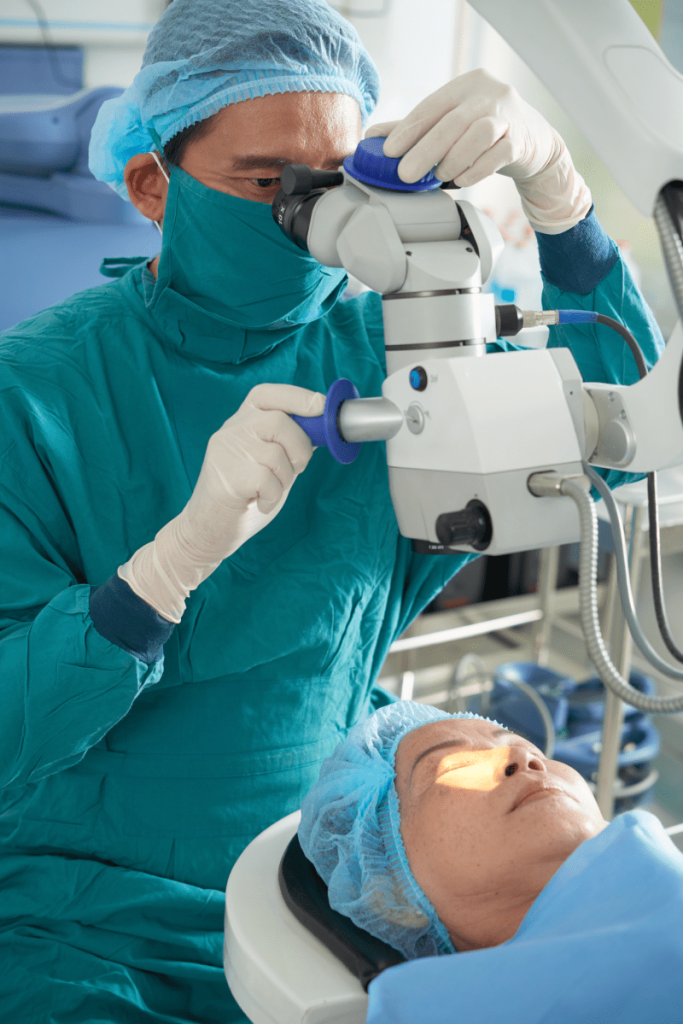
What Additional Items Are Included In Glaucoma Treatment Prices?
In addition to the selected method, glaucoma treatment prices generally include first post-surgical drops and medications, critical control check-ups, and operating room/hospital use fees if surgery was performed. For international patients, packages often include airport transfer and accommodation services. The scope of all these additional items should be clarified when getting a price quote.
What Factors Are Important For Long-Term Success In Eye Pressure Treatment?
The most important factors for long-term success in eye pressure treatment are 100% patient compliance with the treatment (not missing drops), regular doctor check-ups, and maintaining the intraocular pressure continuously at the target level. Furthermore, in case of surgical success, monitoring the control of wound healing and the progression of optic nerve damage with regular OCT and visual field tests is vital.
Why Should Turkey Be Preferred For Glaucoma Treatment?
Turkey should be preferred for glaucoma treatment because it combines internationally accredited hospitals, highly experienced eye surgeons applying the latest surgical techniques (MIGS, Femtosecond Laser), and much more favorable cost advantages compared to Western countries. Turkey offers not only a cost advantage but also fast appointment and treatment initiation, preventing patients from losing time.
What Age Group Is Most Frequently Affected By Untreated Eye Pressure?
Untreated eye pressure (Primary Open-Angle Glaucoma) most frequently affects people generally over the age of 40 and especially those over 60. Age is the biggest risk factor for glaucoma. However, types such as narrow-angle glaucoma or secondary glaucoma can also occur suddenly or at younger ages. Therefore, it is highly recommended for everyone over 40 to have regular eye pressure checks.
How Is Pain Control Provided After Surgery?
Post-operative pain in glaucoma surgeries is generally mild to moderate and is intense for the first few days. Pain control is achieved with oral painkillers prescribed after surgery and sometimes antibiotic/steroid eye drops. Most patients do not experience severe pain, except for mild discomfort. It is important to use the prescribed medications regularly and contact the doctor immediately if the pain increases.
When Can A Patient Undergoing Eye Pressure Treatment Return To Normal Life?
The recovery time for a patient undergoing eye pressure treatment to return to normal life varies according to the applied method. In drop or SLT laser treatment, the patient can usually return to daily activities immediately. After surgery (Trabeculectomy), the patient can usually return to work within 1-2 weeks, but should avoid heavy physical activities and strenuous sports for about 1 month.
